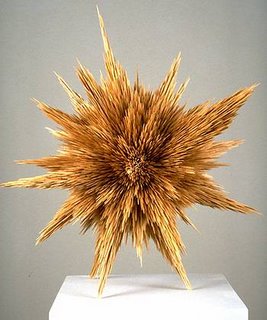Jaume Plensa was the main focus of YSA with a lot of his work being on exhibition. Most of his work was based around human form and quotations, every example of his figures either included a quote or was made up of mass of type. "a single letter on its own can be miss leading and suggestive, a group or body of letters forms a word and a body of words creates a statement." Plensa's work is intertwined with this statement , with alot of his work being broken down to simplistic forms. these forms mainly consist of human figures, differentiating in scale, media and transparency, but almost always seem to be in the fetal position. this gives the impression of fear or protection for the figures that are portrayed. the utilisation of stance to portray an emotive is common throughout the sculptures seen at YSP, e.g. the running man, and Plensa's hear no evil , speak no evil, see no evil exhibit.
another similarity seen here at YSP was interactivity with the static sculptures. this could been seen in Plensa's work with the gongs , allowing the viewer to create a sound and feel a response , and in the totems seen around the park , allowing the viewer to see through the sculpures from the sculptures perspective. this helps the viewer become more involved in the piece and gain a greater understanding of the sculptors idea/ emotive behind the sculpture.
also the ability to see through the sculptures, the use of transparency, was common within this exhibit. most commonly seen in Plensa's work which gives a delicate feel to the large scale sculptures. this can be seen throughout the sculptures in the park, not just in the works by plensa. this ability to transpire , or see through an object portrays the ideas of ghosts, vulnerability and truth to me and this links with the feelings of fear and security that i find linked with the fetal position used by plensa in all of his human form sculptures.
Yesterday is History, Tomorrow is a Mystery, but Today is a Gift, That's why it is called the Present
30/09/2011
22/09/2011
Anthony Gormley
This sculpture (Standing Matter XVIII) by Anthony Gormley portrays a human figure, represented by atomic structure. This could be to visualy represent the fact that all things are made up of the same base structures or possibly to represent the differences between different human forms and how different sections of the human structure can be foremed in different sizes.
the minimal use of shape to create the sillhouette of a human really interests me, how a form can portray an idea without being detailed or definitive.
the minimal use of shape to create the sillhouette of a human really interests me, how a form can portray an idea without being detailed or definitive.
Jaume Plensa
I, You, She or He is a sculpture created by Jaume Plensa of 3 non-descript figures perched on stones. Plensa's sculptures are crafted from metal typography but are shaped in such a way that the typographical elements can be overshadowed by the human form it creates. This use of material creates a semi-transparency to the figures which implies a ghostly feel to the figures. Also the way in which the light is reflected from the metal helps define the form and gives the impression of a human figure. The setting of this peice is also vital to the message of the sculpture and gives it a serene, calm picturesce feel.
The words in the type enveloping the characters are linked to the specific figures Plensa portrays, or the area in which the sculpture is located.
15/09/2011
Tom Friedman
The individual qualities that are appealing is the range of materials and subjects which are not limited to set themes or the normal media used by artists in his field.
This image seen below is made of toothpicks, but creates a very powerful and energetic feel of an explosion.
Richard Deacon
Deacon work is heavily based around natural and human form , inside and out, in the shape and conposure of his sculptures. This gives his work a flowing natural feel. this is also represented in his use of media , be it metal, wood or plastic.
This piece ("orinoco", named after the north american river) is made of wood, represents the trasition of liquids when traveling and shows the natural patter fluids take.
The fluidity of this sculpture and the form that it creates gives a kinetic feel. this makes the sculture interesting for the viewer as it gives rippling, flowing shape for the viewer to follow, these overlap and intertwine and guide the viewer out and around the sculpture.
This piece ("orinoco", named after the north american river) is made of wood, represents the trasition of liquids when traveling and shows the natural patter fluids take.
The fluidity of this sculpture and the form that it creates gives a kinetic feel. this makes the sculture interesting for the viewer as it gives rippling, flowing shape for the viewer to follow, these overlap and intertwine and guide the viewer out and around the sculpture.
Subscribe to:
Comments (Atom)













































